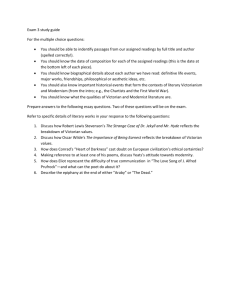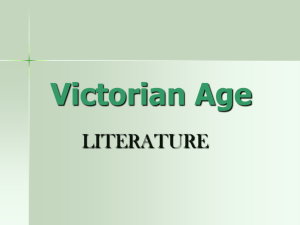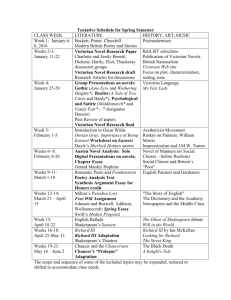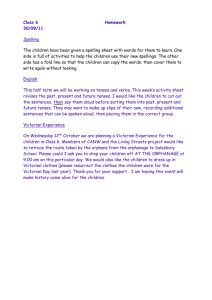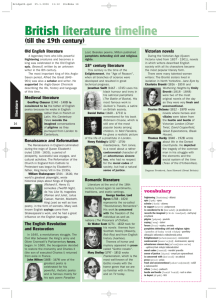The Sisters & their Identities
advertisement
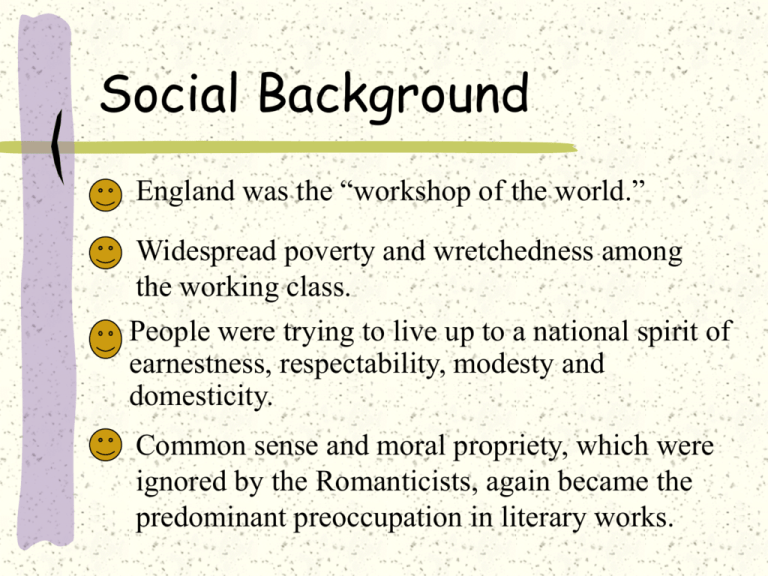
Social Background England was the “workshop of the world.” Widespread poverty and wretchedness among the working class. People were trying to live up to a national spirit of earnestness, respectability, modesty and domesticity. Common sense and moral propriety, which were ignored by the Romanticists, again became the predominant preoccupation in literary works. Victorian Literature Literature produced during this period reflects the “spirit of the times”: Expansion of newspapers and periodicals led to ongoing debates about current political and social issues. Victorian literature (especially novels) offered a realistic, day-to-day portrayal of social life and represented these issues in the stories of the characters. Suddenly, the once-silent female segment of society raised their voices. They could even appear onstage, acting in dramas (a privilege denied to them prior to this time). Victorian Literature Chronologically the Victorian period roughly coincides with the reign of Queen Victoria over England from 1836 to 1901. In literature, the early Victorian age can be said to be the age of critical realism. The critical realism of the 19th century flourished in the forties and in the early fifties. Puritan morality of the early and mid Victorian period was reflected in the novels. In Victorian novels the society’s effects on individual are analyzed. The Victorian Poetry Victorian poetry developed in the context of the novel. Poets sought new ways of telling stories in verse. All poets show the strong influence of the Romantics, but cannot sustain the confidence the Romantics felt in the power of the imagination. Victorian poets often rewrite Romantic poems with a sense of belatedness. Dramatic monologue – the idea of creating a lyric poem in the voice of a speaker ironically distinct from the poet is the great achievement of Victorian poetry. The Victorian Drama The theater was a flourishing and popular institution during the Victorian period. The popularity of theater influenced other genres. Bernard Shaw and Oscar Wilde transformed British theater with their comic masterpieces. Victorian Literature The novel became the dominant form of literature Novels were commonly read aloud in family gatherings. This led to novelists avoiding some topics which would be inappropriate for the entire family. Readers wanted to be guided and enlightened by authors. Much of Victorian literature has a positive, eager or earnest response to the innovations of life in the 19th century The Victorian Novel Victorian novels seek to represent a large and comprehensive social world, with a variety of classes. Victorian novels are realistic, their major theme is the place of the individual in society, the aspiration of the hero or heroine for love or social position. The protagonist’s search for fulfillment is emblematic of the human condition. For the first time, women were major writers: the Brontës, Elizabeth Gaskell, George Eliot. The Victorian novel was a principal form of entertainment. Victorian Novels Most were concerned with people in society and with manners, morals and money. Typically a protagonist struggles to find him or herself in relation with other men and women, in love or marriage, with family or neighbors, or with work associates. Most novels were set in 19th century England, a world that would be recognizable to the reader. Many novels were published in installments. This challenged the writer to sustain the interest of the readers. In every single installment they had to entertain. Aspects of Victorian Novels Realism – capturing everyday life as it really is lived; identified social problems: Charles Dickens,Charlotte Brontë, & Emily Brontë. Psychological realism – focused on inner realities of the mind: George Eliot’s. Naturalism – views nature and society as forces indifferent to human suffering. E.g. Thomas Hardy. Novel of Realism Renders reality closely and in comprehensive detail. Characters appear in their real complexity of temperament and motive; They are in explicable relation to nature, to each other, to their social class, to their own past. Character is more important than action and plot; Complex ethical choices are often the subject. Events will usually be plausible. Realistic novels avoid the sensational, dramatic elements of naturalistic novels and romances. Charles Dickens (1812-1870) Without doubt the most popular of Victorian writers was Charles Dickens. His combination of sentimentality and his attacks on the social evils of the day made him highly successful. He is concerned with the problems of crime and poverty and the life of the lower class. The Brontë sisters Charlotte (1816-1855): Jane Eyre Emily (1818-1848): Wuthering Heights Anne: Agnes Grey The Sisters & their Identities Wutheirng Heights and Agnes Grey were accepted for publication before Charlotte had finished writing Jane Eyre. However, their publisher delayed bringing their novels out so that Jane Eyre was published first. It became a best seller. In an effort to cash in on the success of Jane Eyre, he implied that Wuthering Heights and Agnes Grey were written by "the author of Jane Eyre–to the distress of all three sisters. The pseudonyms they had adopted unintentionally contributed to his deception. The Sisters & their Identities Wanting their works to be judged for their literary merit and not on their sex, Anne, Charlotte, and Emily published their novels under names which were not obviously masculine, Acton, Currer, and Ellis Bell. Preserving their male identities was so important to the Brontë sisters that Charlotte maintained that identity even in writing to her publishers. In order to prove to Charlotte's publishers that Acton, Currer, and Ellis Bell were not one person, Charlotte and Anne met with them in London; during the interview, Charlotte inadvertently revealed that they were three sisters. Charlotte Brontë Charlotte wrote three other books, Shirley, Villette,and The Professor.In 1854 Charlotte married.But she died in the following year after a lengthily painful illness. Charlotte Bronte published Jane Eyre under the pen name Currer Bell, in London in 1847. George Eliot (1819-1880) The pseudonym of Mary Ann Evans, born in Warwickshire, England in 1819 Called “the embodiment of philosophy in fiction” by Oscar Wilde Adam Bede (1859) The Mill on the Floss (1860) Silas Marner (1861) Middlemarch () Daniel Deronda (1876). Naturalism Characters’ lives are governed by scientific determinism, i.e., heredity and environment. To show this determinism, naturalists often create weak and passive characters. Sex and violence are bed partners; sex is brutish, without tenderness. Violence dominates the lives of the naturalistic character. Thomas Hardy The last and one of the greatest of Victorian novelists His best local-colored works: 1. 2. 3. 4. The Return of the Native The Mayor of Casterbridge Tess of the D’Urbervilles Jude the Obscure (1840-1928) According to traditional writing techniques developed before the 20th century, a piece of narrative works should tell a vivid, interesting story and portray one or more characters who have distinct traits and who are often involved in certain kind of psychological or social conflicts which, with the development of the plots, will in the end come to certain solution. This kind of notion, however, was fiercely attacked since the end of 19th century. Since then the concept of narrative literature and its writing techniques have undergone profound changes. Stylistic Innovations of Modernist Novels Reality as understood by traditional writers was merely the mortal beings and natural objects in the material world. Thus the task of the traditional writers was to reflect and imitate this exterior world. Modern short story writers, however, turn to explore and delve into man’s interior world. Instead of looking at the stern reality from the angles of money, class status, social desire, or other material desires, they tend to be preoccupied by the sub-consciousness of the mind; they pay more attention to human beings’ experience, feeling, and introspection.

